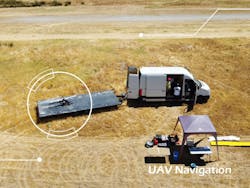UAV Navigation announces its flight control system enables fully autonomous maritime UAV operations
MADRID - UAV Navigation in Madrid, Spain, has announced that the company's autopilots can now perform a fully autonomous maritime operation without any manual input through all the flight stages: take-off, flight plan execution and landing.
The flight control system has been upgraded to execute such missions from vessels underway at sea or from moving platforms. This is achieved without any extra hardware or third-party devices to enhance system capabilities. UAV Navigation says its flight controller is able to execute the entire mission, thereby reducing operator workload to a minimum.
The VECTOR range of autopilots includes referenced navigation capabilities that allow the system to follow a moving landing site in order to perform a precise automatic landing under dynamic conditions. The system is able to control a safe touchdown even in conditions as poor as Sea State 4.
UAV Navigation's system has been proven for maritime environments and the hardware is qualified to MIL-STD-810F and MIL-STD-461, including a salt spray test, electromagnetic compatibility tests and RF shielding tests that ensure the system will continue to perform in the 'noisy' environments that are typically encountered onboard large vessels.
The system performs a completely automatic landing onto a platform which is moving at a speed of up to 30 km/h or 16 knots.
Some of these use cases have meant that UAVs are already in use by governments and agencies such as the European Maritime Safety Agency (EMSA).
